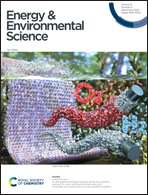Thermally controlled growth of photoactive FAPbI3 films for highly stable perovskite solar cells†
Abstract
We employ flash infrared annealing to investigate the phase transition of formamidinium lead triiodide (FAPbI3) thin films for their solar cell applications. Measuring the enthalpy changes of the FAPbI3 composition at different heating rates allows us to calculate an activation energy of 1.8 eV for the black perovskite phase transition. We explore different heating regimes for triggering the phase transformation and analyze the evolution of the microstructure with an empirical calculation of the average crystal growth velocity required to form a compact film on the micron and submicron scales. The films were then optoelectronically and structurally correlated by mapping the typical spherulite microstructure of grain domains, indicating a direct relationship between film homogeneity and higher crystal growth rate. Accordingly, we manufactured highly stable black FAPbI3-based perovskite solar cells using the optimal film crystallization processing parameters, with an annealing time of just 640 ms. We achieve a power conversion efficiency (PCE) of 18.5% using the champion device in the absence of any additives, incurring merely a 10% loss in the PCE during maximum power point tracking for 1500 h under full solar intensity exposure of the devices.



 Please wait while we load your content...
Please wait while we load your content...